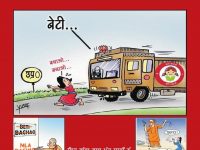Shabbirpur village in Saharanpur district is the latest addition to the growing list of places where Dalits have risen against the injustices and atrocities of upper castes. On May 21st 2017, thousands of Dalits from western UP, particularly Saharanpur, came to the Jantar Mantar protest site in the capital to express their resolve to fight against attacks on them.
Shabbirpur coming after Una and Sangrur has added a new dimension to the struggle of Dalits and oppressed castes in the country. In Una, the beating of Dalit youth by RSS hoodlums had led to big protests by Dalits and progressive organizations in Gujarat. Those leading the protest had called for Dalits to shun skinning of dead cattle and demanded that Dalits be given land to which they are entitled. Una protests had once again highlighted the question of land for Dalits. Una became a symbol of not only a new wave of protests by Dalits but also the raising of land question by oppressed castes in their fight against caste oppression and attacks.
Earlier, in Sangrur district of Punjab, Dalits had been struggling under the banner of Zamin Prapti Sangharsh Committee for the share of panchayat agricultural land legally earmarked for Dalits for lease. This land to which Dalits are legally entitled was being enjoyed by Jat landlords through various dubious methods. This struggle, continuing for last three years, has faced serious repression by the state govt. and attacks by landlords. An 80 year old woman, Gurdev Kaur, became a martyr last year in the attack by the landlords. Ballad Kalan and Jaloor became symbols of resistance to the landlords’ attacks. This struggle scored many victories forcing the Govt. to give lease to Dalits for their share of panchayat land in a number of villages and reduce the price of lease. The land thus enjoyed by Dalits not only brought economic gains but, and more importantly, social status. Women played a very active role in this struggle seeing land as an instrument of freedom for harassment by landlords.
Shabbirpur witnessed vicious attacks against Dalits by Rajputs on May 5, 2017. The issue of playing loud music in front of Ravidas temple and Dalits’ opposition to it, escalated into all out attack against Dalits. A big crowd of Rajputs had assembled ostensibly to celebrate Maharana Pratap Jayanti. Rajput youth played loud music before Ravidas temple and when objected to by Dalits made several rounds before the temple. This crowd moved to attack the temple under the excuse that stones were pelted on them from inside the temple. The statue of Ravidas was broken, thrown on the ground and things were also set on fire. A Rajput youth died while coming out of the temple. Indian Express reported that according to the postmortem, the cause of death was suffocation. This incident was used to launch an all out attack against Dalits. Over 50 houses of Dalits were consigned to fire. Their shops on the roads were burnt down. 12 Dalits were injured, one of them received serious injuries. Five of the injured were women.
Shabbirpur, a village nearly 25 kms from Saharanpur in Uttar Pradesh, has had a long history of conflict between Rajputs and Dalits. In the month of April 2017, Dalits were prevented from installing a statue of Dr. B.R. Ambedkar on the ground that they did not have permission to do so. But Rajputs were allowed to take out a big procession without any permission, with police remaining spectators. Earlier conflicts had been on a number of issues. The village has nearly one thousand Rajput and 600 Dalit voters. Rajputs own most the land while some Dalits also possess some land, an eyesore for Rajputs who view this as the cause of their arrogance!
Shabbirpur is not alone. Since Yogi Adityanath (Ajay Singh Bisht) Govt. coming to power in UP, in several places attacks have been mounted against Dalits. Sambhal, Badaun and Aligarh have been the more talked about centres of such attacks. While attacks against Muslims have been routine in western UP thanks to deep seated communalization of police and administrative machinery, attacks against Dalits have grown in number since advent of Yogi Govt. It is a sort of upper caste assertion after the long spell of SP and BSP in power. Hindutva is essentially upper caste chauvinism and stands for preservation and perpetuation of power of upper castes, basically their landlord sections. So the attacks against Dalits are not an aberration but an essential part of Hindutva agenda. While Modi and the like from RSS make a show of their caring for Dalits, they wish only to use them for attacks against Muslims to carve out communal polarization. Anti-Muslim rally held by BJP MP from Saharanpur, Raghav Lakhanpal, in the name of Ambedkar is a clear pointer to their design. The same Raghav Lakhanpal is siding with Rajputs in Shabbirpur. The message is clear. Dalits are welcome to participate in anti-Muslim violence but they dare not challenge the hegemony of upper castes! Hindutva is a response of a section of ruling classes to the growing struggles of the oppressed sections, to disrupt their unity and to bring them under the sway of upper castes, particularly landlords. That this Hindutva is quite cozy with corporate shows the joint rule of big landlords and big capitalists in the country. Hindutva has also been and is a useful tool in the service of imperialist powers, particularly western imperialist powers. It is not accidental that ideology of Hindutva took birth and prospered under the aegis of British colonial rulers and is still viewed by imperialist powers as a useful and powerful weapon against the anti-imperialist, progressive and democratic aspirations of the people of this country.
Shabbirpur has demonstrated complete connivance of police and administrative machinery in these attacks on Dalits. Police not only watched this attack on Dalits but also participated in attacking Dalits. A number of Dalits were arrested though they were the ones attacked. Police did not even record the statements of the injured till several days after the attack. Police had not allowed installation of Ambedkar statue in the name of lack of permission but did not prevent Rajputs from taking out their rally. Dalits were denied permission to hold a protest against Shabbirpur attack at Gandhi Chowk in Saharanpur on May 9 and those who had assembled were lathicharged, several of them injured.
Due to support of police and administration, attacks by Rajputs against Dalits are continuing. On May 23, when BSP chief Ms. Mayawati went to the area, Rajputs attacked, with swords and firearms, Dalits returning from her meeting. In these attacks a number of Dalits were injured, thirteen of them seriously, and one youth died in the attack. This has also not spurred Modi-Yogi dispensation to act against the attackers. State Govt. has confined itself to timeworn tactic of transferring SP and DM, once after May 5 and second time after May 23. These are merely eyewash. RSS has a strong base among Rajputs in this and neighbouring villages and conducts shakhas in these villages.
While attacks against and atrocities on Dalits and other oppressed castes are quite routine, these have grown in number and intensity since RSS-BJP Yogi dispensation in power at the Centre. However, what distinguishes Shabbirpur and other incidents is the protest and resistance put up by Dalits against these attacks. They are not willing to take these attacks without resistance. Big demonstration held in Delhi on May 21 in which a large number of Dalits from Saharanpur participated, shows the anger of Dalits over this incident and rising flame of resistance to these atrocities among them. Bhim Army Ekta Mission had called for the protest demonstration in Saharanpur on May 9 and Delhi rally. Bhim Army activists led Dalits particularly Dalit youth in these protests, even conducting road blocks at a number of places. They have been Dalits whose houses had been burnt and who suffered injuries.
While Mayawati has exhorted Dalits to remain only in BSP (obviously targeted against Bheem Army), the anger of Dalit youth against oppression is boiling. In fact Ms. Mayawati had announced her rally after the big turnout during Jantar Mantar rally called by Bhim Army. Dalits are not satisfied with just placing a few of their leaders in power through elections, but want freedom from attacks by upper castes and domination of the landlords belonging to these castes. Saharanpur and before that Una, highlighted that leadership of these agitations is willing to challenge the basis of caste oppression. Intellectual sections from Dalits are also challenging the policy framework of the ruling classes and are willing to stand by their convictions in face of attacks by the Govt. Students of Ambedkar-Periyar Society in Chennai and Rohit Vemula and others of Ambedkar Students Association in Hyderabad Central University had raised the issues pertaining to different anti-people policies of the Govt. These are positive developments for mobilization of these sections for revolutionary transformation of society. There is an urgent need that all sections struggling against ruling classes should come together. However, such a unity will be forged in the melting pot of struggles. Its path may not be straight, its course may be somewhat long yet such a unity must be forged and can be forged. It is very important for intensification of struggle for new democratic transformation of India. Its need is urgent.


